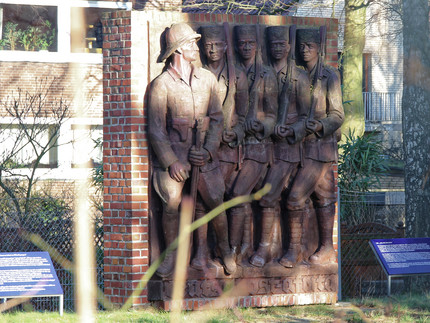Have you ever heard of the Maji Maji War?
In 2021, the genocide committed by the German Reich against the Ovaherero and Nama was finally recognized by the German government. Much less known is the Maji-Maji war in the colony 'German East Africa', which took place almost at the same time. According to estimations of the Tanzanian scientist Gilbert Gwassa, it claimed up to 300,000 - almost exclusively African - lives.1,2
Maji means 'water' in Kiswahili, but in this context, it refers to a 'magic' mixture of maize, sorghum grains and water. It was supposed to make the fighters invulnerable and thus help them out of oppression by the colonizers.1
Trigger factors included high tributes and forced labor. The message of the Maji magic of the healer Kinjikitile Ngwale united various African societies into a broad resistance movement against the colonial oppressors.1,3 The Maji Maji War began on July 20, 1905, with the symbolic destruction of a cotton field by resistance fighters. It ended in 1907 after many brutal battles and a devastating famine due to the complete destruction of numerous villages, fields, and supplies by colonial troops, which consisted largely of African mercenaries.2
The merciless destruction of supplies, fields, wells, and entire settlements has also been referred to as the 'scorched earth strategy' since the 1960s.1,4
During the war itself, but also until about 20 years ago, the Maji Maji War was referred to as a rebellion. The term 'rebellion' itself is influenced by colonial patterns of thought and goes hand in hand with the assumption that, as Europeans, they belong to a higher degree of civilization.5 From this point of view, the African people were not opponents of equal value, and the conflict was consequently only a rebellion and not a war. Scholars today uniformly refer to the events as a war, which not only contributes to the recognition of German crimes, but also corresponds to historical reality.5
References
[1] Becker, Felicitas; Beez, Jigal (Hg.) (2005): Der Maji-Maji-Krieg in Deutsch-Ostafrika. 1905 - 1907. 1. Auflage. Berlin: Links (/Schlaglichter der Kolonialgeschichte], 3).
[2] Bundeszentrale für politische Bildung (2023): Vor 115 Jahren: Der Maji-Maji-Aufstand (Hintergrund aktuell). Online verfügbar unter www.bpb.de/kurz-knapp/hintergrund-aktuell/209829/vor-115-jahren-der-maji-maji-aufstand/, zuletzt aktualisiert am 10.02.2023.
[3] Werner, Frank (Hg.) (2019): Die Deutschen und ihre Kolonien. Das wilhelminische Weltreich 1884 bis 1918 2019,4. Hamburg: Zeitverlag Gerd Bucerius GmbH & Co. KG.
[4] Wiedemann, Charlotte (2022): Den Schmerz der Anderen begreifen. Holocaust und Weltgedächtnis. Berlin: Propyläen.
[5] Haug, Frederik (2018): Verbrannte Erde. Die Haltung der Bundesregierung hinsichtlich des kolonialen Gewalthandelns des Deutschen Kaiserreichs in Deutsch-Ostafrika. Potsdam: Universitätsverlag Potsdam (WeltTrends Thesis, Band 21 (2018)). Online verfügbar unter publishup.uni-potsdam.de/opus4-ubp/frontdoor/deliver/index/docId/41123/file/wtthesis21.pdf, zuletzt geprüft am 10.02.2023.
[6] Natermann, Diana M. (2016): Der Maji-Maji-Krieg. Ein historischer Einschnitt der deutsch-tansanischen Kolonialgeschichte. Ausstellung "Heikles Erbe - koloniale Spuren bis in die Gegenwart". Landesmuseum Hannover, 15.11.2016. Online verfügbar unter www.academia.edu/30052625/Der_Maji_Maji_Krieg_Ein_historischer_Einschnitt_der_deutsch_tansanischen_Kolonialgeschichte, zuletzt geprüft am 10.02.2023.

